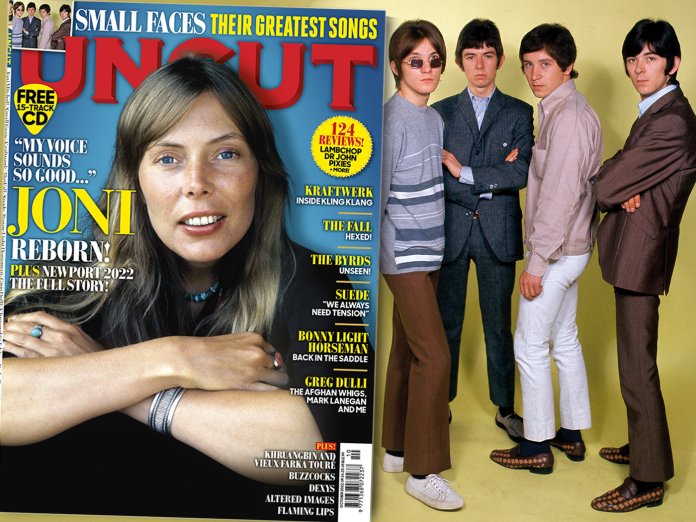In the latest issue of Uncut magazine - in UK shops from Thursday, August 18 and available to buy from our online store, Nick Hasted convenes a panel of Small Faces' friends and labelmates to join sole surviving member Kenney Jones in considering 20 of their greatest songs. Jones will be releasing...
In the latest issue of Uncut magazine – in UK shops from Thursday, August 18 and available to buy from our online store, Nick Hasted convenes a panel of Small Faces’ friends and labelmates to join sole surviving member Kenney Jones in considering 20 of their greatest songs. Jones will be releasing The Autumn Stone expanded boxset this autumn on Nice Records label, which he revived last year with plans to reissue all of the much-loved Small Faces albums.
Recently, Kenney Jones has been digging through his personal archive. He has been searching for Small Faces songs he stored away as a young man, just hours after they were recorded, but which have since languished in obscurity. “Every time we recorded something, I always asked for a reel-to-reel copy to take home,” the sole surviving Small Face explains. “So I’ve got backing tracks, rough mixes and unmixed tracks, among other things.”
Some of these, he acknowledges, will finally see the light of day on an expanded boxset of their compilation album, The Autumn Stone. Originally released in 1969, The Autumn Stone capped the Small Faces’ brief but magnificent recording career. Although together for less than four years, the Small Faces’ mastered R&B, psychedelia, Essex folk-rock reveries and blissed-out spiritual ballads – high-water marks of ’60s pop. To celebrate The Autumn Stone boxset, Uncut has convened a panel of the band’s friends and labelmates to join Jones in considering 20 of their greatest songs.
These include former Humble Pie man Peter Frampton, erstwhile Immediate Records manager Andrew Loog Oldham, US soul singer PP Arnold and Brit R&B singer Chris Farlowe, along with rock photographer Gered Mankowitz, Jerry Shirley – a teenage signing to Oldham’s Immediate label who became Steve Marriott’s Humble Pie drummer – and Lyn Dobson, session man for the Small Faces and folk-rock loyalty such as Nick Drake. They all have fond stories to tell about the mod scamps – and all concur that the Small Faces had the songs and the singer to take on the world.
“Steve had two sides,” says engineer Alan O’Duffy. “One was the cockney, happy stage man who’d played the Artful Dodger. The other was a black soul singer. When he worked with PP Arnold, she was like the ambition of Steve’s heart, in musical terms.” Arnold herself is keen that he’s properly remembered: “So long as I’m alive, I’m going to keep Steve’s vibe alive.”
Along with keyboardist Ian McLagan and bassist Ronnie Lane, all four Small Faces’ work is recalled here with equal affection and in chronological order.
1. “WHATCHA GONNA DO ABOUT IT”
(1965 7-inch, also on 1966’s Small Faces LP)
This debut single was an impeccable mod-pop calling card, reaching No. 14
PETER FRAMPTON: The very first time I saw the Small Faces was on Ready Steady Go!, doing “Whatcha Gonna Do About It” – a song I hadn’t heard yet. It was a phenomenal rendition. And you go, ‘Is that guy singing? He sounds like a 69-year-old black man. But he’s 20-odd and five foot nothing.’ About halfway through, when Steve does that feedback solo, I thought, ‘I wanna play with that guy.’ I wanted to join the Small Faces, to be honest. The song’s R&B with a real strut, the perfect first hit for them. That was before Mac was even in the band. That was it, I was so into the Small Faces from that point on to the end. Of course, I later joined Steve in Humble Pie. So that song has great meaning to me.
2. “SHA-LA-LA-LA-LEE”
(1966 7-inch and on the 1966 Decca album Small Faces)
Near nonsense (penned by Kenny Lynch and Mort Shuman) made great by joyous, bulldozing conviction, taking it to No. 3
GERED MANKOWITZ: I liked the sound they made on “Sha-La-La-La-Lee”. An irresistible R&B pop song that rides on the energy of the band, the beat and Steve’s voice. Maybe the song was nonsense, but I never focus too much on lyrics; it was the feel, it was emotional. I’d already known them for a year before that came out – when Jimmy Winston was still in the band and they were with Don Arden. The Small Faces were their own people, with their own ideas. I felt very close to them, but they were quite tricky to work with, because they were always searching for a prop to hide behind. Photographing them was always compromised and sometimes the compromise would make the picture, like when Steve’s flicking V signs at the camera. That’s got a lot of the Small Faces’ energy and character. Not giving a tinker’s toss.
PICK UP THE NEW UNCUT FOR THE FULL STORY



